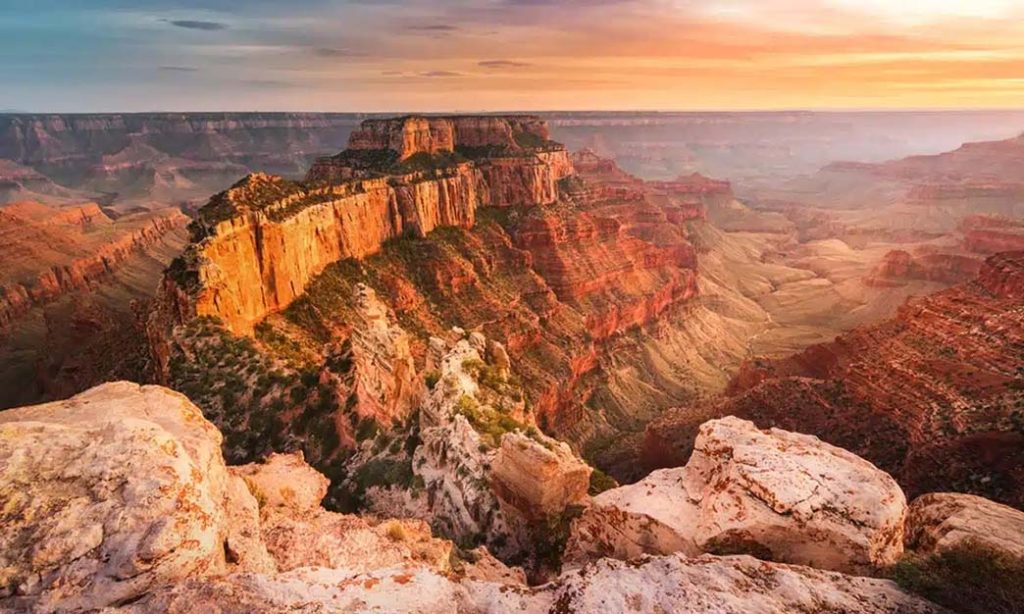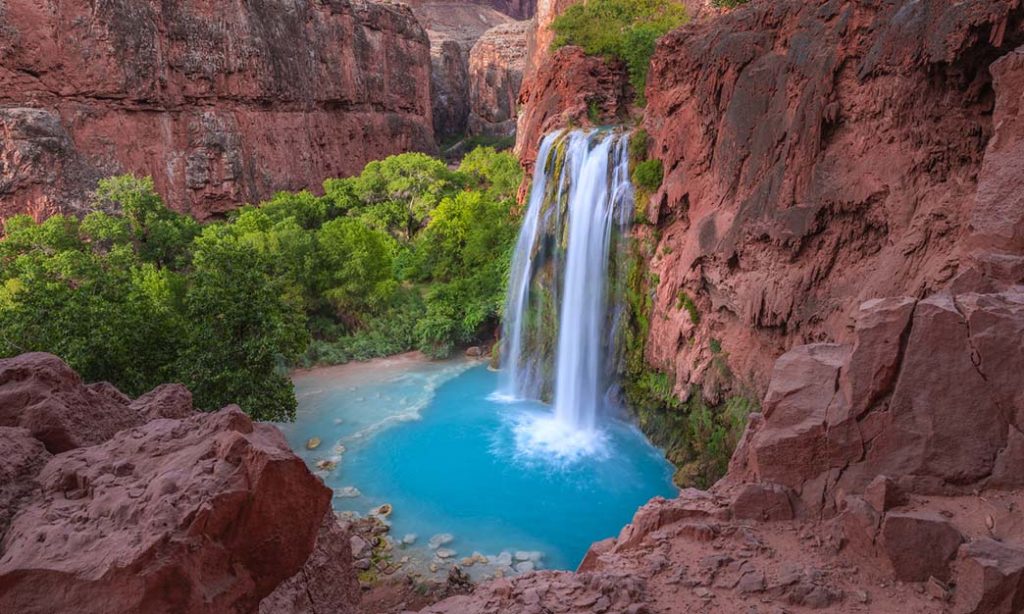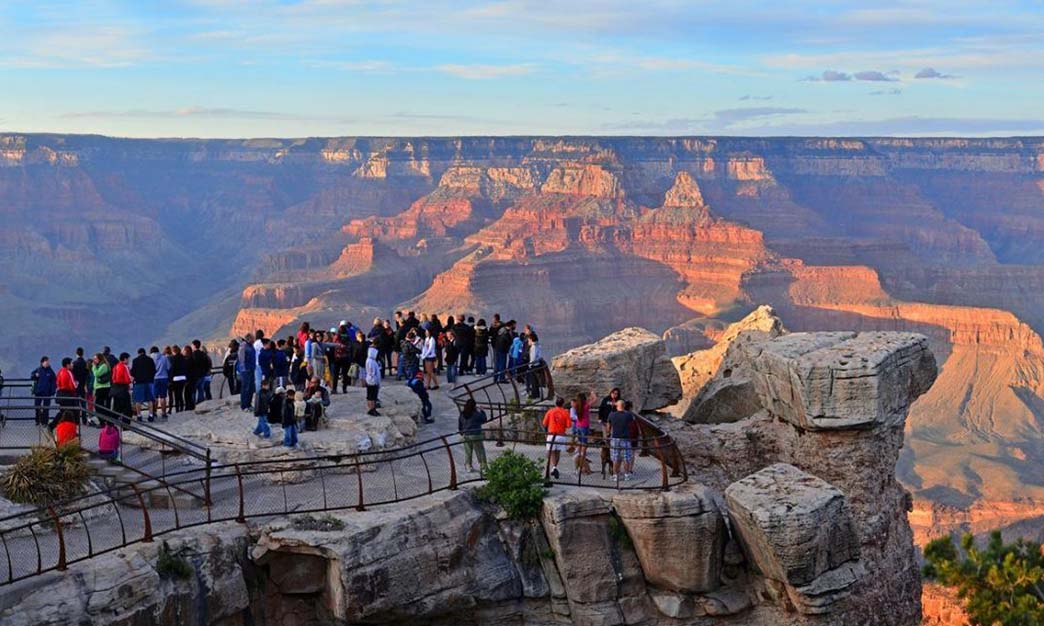This colossal geological marvel, sculpted by the Colorado River over millions of years, not only offers breathtaking vistas but also serves as a sanctuary for a diverse range of wildlife. I will share my detailed experiences and personal insights from three distinct locations within the Grand Canyon, complete with information on their geographical positions, travel routes, pricing, and booking platforms. I will also recommend four other remarkable destinations within the Grand Canyon region and provide valuable tips and suggestions for your journey.
Exploring the Grand Canyon’s Wildlife:
South Rim: An Iconic Introduction
The South Rim of the Grand Canyon is perhaps the most iconic and heavily visited area of this natural wonder, situated in northern Arizona within the boundaries of the Grand Canyon National Park.
To reach the South Rim, you can either fly into Flagstaff Pulliam Airport and embark on a scenic drive to the park or make the journey by car directly from nearby cities. Alternatively, shuttle services are available from major cities such as Phoenix and Las Vegas.
The entrance fees for the Grand Canyon National Park vary, with discounts offered to seniors, military personnel, and annual pass holders. As of my last visit in 2022, vehicle entry was priced at $35, while a 7-day individual pass cost $20. Ensure you verify the most up-to-date pricing on the official National Park Service website.
You can conveniently purchase park entrance passes in advance through the official Grand Canyon National Park website or at the park’s entrance stations. Additionally, accommodations within the park, including hotels and campsites, can be reserved online via the park’s website or various third-party booking platforms.
My journey to the South Rim of the Grand Canyon was filled with eager anticipation. As I approached the canyon’s precipice, the sheer vastness of the landscape was nothing short of overwhelming. The beauty of the South Rim extends beyond the dramatic vistas of the canyon itself, encompassing the abundant wildlife that thrives in this remarkable place.
During my exploration of the South Rim, I had the privilege of encountering a myriad of wildlife, including mule deer, California condors, and rock squirrels. Mule deer, with their graceful appearance and distinctive ears, were a common sight as they foraged along the rim. The California condors, on the other hand, are a critically endangered species, and witnessing these magnificent birds soar above the canyon was a rare and unforgettable experience. Rock squirrels were also ubiquitous and known for their curiosity, occasionally attempting to abscond with food from unsuspecting visitors.
The South Rim serves as an ideal gateway to the Grand Canyon’s astounding beauty and biodiversity. The sheer grandeur of the canyon walls, the vivid hues of the rock formations, and the serendipitous encounters with its untamed inhabitants etched an indelible mark on my soul. I would highly recommend allocating at least two days to fully appreciate the wonders of this area.
North Rim: A Hidden Gem
The North Rim of the Grand Canyon is the less-frequented counterpart to the South Rim, offering a more secluded and tranquil experience. It is situated in northern Arizona, approximately 215 miles by road from the South Rim.
Reaching the North Rim entails a longer journey compared to the easily accessible South Rim. Visitors can choose to fly into Flagstaff Pulliam Airport or St. George Regional Airport and then embark on a picturesque road trip to the North Rim. The drive meanders through picturesque forests and high plateaus.
Entrance fees for the North Rim mirror those of the South Rim, with discounts available for eligible groups. As before, it’s essential to verify the current prices on the National Park Service website when planning your visit

Much like the South Rim, you can procure park entrance passes and secure accommodations within the North Rim through the official Grand Canyon National Park website or various third-party booking platforms.
My visit to the North Rim was a departure from the bustling crowds of the South Rim. It provided a more intimate and tranquil experience, allowing me to forge a deeper connection with the Grand Canyon’s natural splendor.
The North Rim is a haven for wildlife enthusiasts. During my time there, I had the privilege of spotting bighorn sheep, Kaibab squirrels, and peregrine falcons. Bighorn sheep, with their iconic curved horns an
d nimble agility on rocky terrain, were an impressive sight. Kaibab squirrels, with their distinctive white tails, are a unique subspecies found exclusively in the North Kaibab Plateau region. Peregrine falcons, renowned for their breathtaking aerial displays, were a thrill to observe as they pursued their prey.
The North Rim is a hidden gem that offers a quieter and more immersive communion with nature. The dense forests, cooler temperatures, and profusion of wildlife make it an ideal sanctuary for those in search of respite from the crowds. It’s prudent to plan your visit well in advance, as accommodations tend to fill up swiftly, particularly during the peak summer months.
Havasu Falls: An Oasis in the Desert
Havasu Falls is a striking natural spectacle nestled within the Havasupai Indian Reservation, situated on the western fringe of the Grand Canyon in Arizona.
Embarking on a journey to Havasu Falls is an adventure in itself. The trailhead commences at Hualapai Hilltop, located approximately four hours by road from the South Rim of the Grand Canyon. From there, visitors must embark on a challenging 10-mile hike or opt for a horseback ride to reach the falls. The trail is demanding but immensely rewarding.

To visit Havasu Falls, it is imperative to secure a reservation through the Havasupai Tribe’s official website. As of my last visit, fees included a camping permit, an entrance fee, and an environmental fee. Prices varied based on the time of year and the chosen type of accommodation. Ensure you check the most current pricing and availability on the tribe’s website.
My expedition to Havasu Falls was fraught with eager anticipation and excitement. The strenuous hike through the desert landscape, with the promise of an opulent oasis at its culmination, constituted an exhilarating experience.
Havasu Falls is renowned not just for its azure waters but also for its distinctive desert wildlife. While camping near the falls, I was fortunate to witness ringtail cats, canyon tree frogs, and the elusive desert bighorn sheep. Ringtail cats, resembling a cross between a raccoon and a fox, are nocturnal creatures that occasionally venture out during the day. Canyon tree frogs are distinguished by their melodious calls, which resonate through the canyon walls at night. Observing these creatures in their natural habitat was a privilege.
Havasu Falls is a genuine desert oasis and a paradise for nature enthusiasts and adventure seekers alike. The resplendent blue waters and luxuriant vegetation stand in striking contrast to the arid expanse surrounding them. It is imperative to be adequately prepared for the hike, given the challenging desert terrain. Carrying ample water, donning suitable footwear, and demonstrating respect for the environment are all pivotal to ensure a safe and gratifying visit.
Recommendations and Tips
Respect Wildlife and the Environment:
- Exercise caution when encountering wildlife, maintain a safe distance, and refrain from feeding them.
- Adhere to Leave No Trace principles by responsibly disposing of all trash and waste.
Plan Ahead and Book in Advance:
- The Grand Canyon is a highly sought-after destination, necessitating meticulous planning, particularly during peak seasons.
- Make reservations for permits and accommodations as early as possible, especially for destinations like Havasu Falls.
Stay Hydrated and Be Prepared:
- The Grand Canyon’s desert environment can be unforgiving, so it is essential to carry a sufficient supply of water, sunscreen, and appropriate clothing.
- Monitor the weather forecast and prepare for temperature fluctuations, especially at higher elevations.
Exercise Caution with Wildlife:
- Although wildlife encounters can be exhilarating, it is imperative to exercise caution, avoid approaching or disturbing animals, and securely store food to prevent wildlife from accessing it.
Four Other Grand Canyon Destinations to Explore
- Antelope Canyon: Situated in Page, Arizona, Antelope Canyon is renowned for its narrow and winding sandstone passageways, as well as the breathtaking light beams that filter down from above.
- Horseshoe Bend: Located just a short drive from Page, Horseshoe Bend offers sweeping views of the Colorado River as it gracefully curves around a massive sandstone bend.
- Grand Canyon Skywalk: Situated on the Hualapai Reservation, the Skywalk consists of a glass bridge that extends over the Grand Canyon, providing an exhilarating perspective from high above.
- Toroweap Overlook: A remote and less-visited spot on the North Rim, Toroweap offers awe-inspiring vistas of the Colorado River from a steep and sheer cliff.
The Grand Canyon, a globally acclaimed natural wonder, beckons not only with its awe-inspiring panoramas but also with its rich tapestry of wildlife and ecological diversity. My excursions to the South Rim, North Rim, and Havasu Falls have afforded me the opportunity to perceive the grandeur of this extraordinary destination from varying vantage points. With meticulous planning, reverence for the environment, and an appreciation for the wildlife that inhabits this domain, your voyage to the Grand Canyon is poised to be a transformative and unforgettable odyssey.



